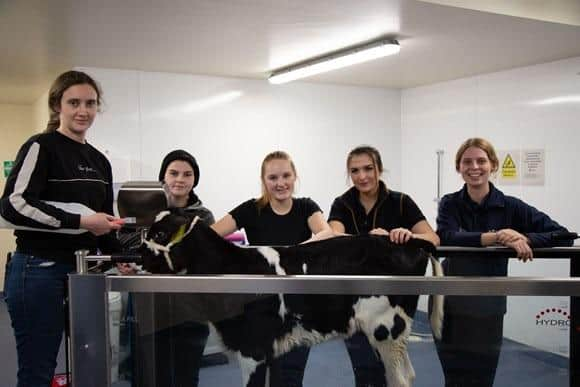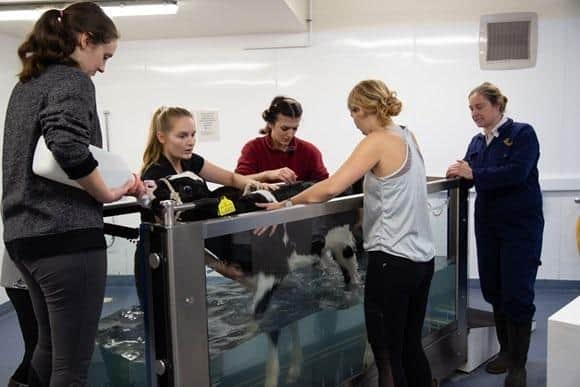Unique project rehabilitates dairy calf 'Bunny' with hydrotherapy
and live on Freeview channel 276
The project came about after a calf born into the University’s dairy herd had difficulty walking.
A spinal issue affected the calf’s gait–as Veterinary Physiotherapy Programme Manager at Harper Adams, Helen Morrell, explains: “Instead of taking individual steps with her hindlegs she could only jump them both together, just like a rabbit hopping.
Advertisement
Advertisement
“As well as being a tiring way of moving, she wasn’t developing the correct muscles for movement or balance - and leaving her unable to properly walk would have been life-limiting.”


After Horizon Dairy Vets, who treat the Harper Adams herd, had tried a series of traditional approaches, they referred her to the Vet Rehab centre run by the University’s veterinary physiotherapy team.
Vet Charlie Moss added: “The hindlimb weakness seen in Bunny was non-responsive to an initial treatment plan of anti-inflammatories and careful husbandry.
“Despite this, she remained bright and healthy so alternative therapies were discussed, with a referral being made to the Harper Adams University physiotherapy department.
Advertisement
Advertisement
“Physiotherapy is a seldom used discipline within farm species - however in Bunny's case, we were lucky enough to have both the facilities and knowledge on site to try hydrotherapy, which has yielded some very promising results!”


The Harper physiotherapy team decided to name the calf Bunny – after her unusual way of walking – and began developing a programme of rehabilitation, lead by a group of final year BSc (Hons) Veterinary Physiotherapy students, uniquely using a water-based rehab programme.
The campus houses a hydrotherapy suite, including an underwater treadmill, which is more commonly used with canine clients – but which was able to accommodate Bunny because of her small size.
Helen added: “The water works in two ways, it slows her movement down and prevents her from being able to hop, and she also has to pull her legs through against the resistance the water provides which strengthens her muscles.
Advertisement
Advertisement
“In the water treadmill the easiest way to move is one leg at a time, which is the way we want Bunny to learn to use her legs. With repeated short bursts of walking underwater on the moving belt we have been able to get her using each hindleg individually.”
While the veterinary physiotherapy team and Harper Adams students have worked with many kinds of animals before, both in the centre and out at various sites, the unique nature of the case presented some challenges.
Upon examining previous cases, Helen and the team were unable to find a similar procedure being used on cattle – meaning the processes they were developing for Bunny had to be specifically tailored for her treatment, even including training her to walk on a halter and rope before anything else.
Helen added: “This is the first calf case I’ve seen referred for physiotherapy because of a neurological issue affecting gait in this way.
Advertisement
Advertisement
“We have treated adult cows before for various musculoskeletal conditions, but not for anything involving their nervous systems dysfunctioning to the extent that they cannot properly walk.
“There are no case studies to follow in textbooks, or in scientific journals, so we’ve had to work from first principles and a knowledge of what works in other species, such as horses and dogs, to clinically reason our treatment approach.
“The students have used some great problem-solving skills in tackling this case, and, for what I understand to be a first, have successfully used an underwater treadmill designed for dogs within the rehabilitation plan.”
Throughout the winter term, the students and Vet Physio team worked to rehabilitate Bunny. The student team who took part included Caitland Yates from Buckinghamshire, Millie Hawe from West Sussex, Jess Tiley from Hertfordshire, Courteney Wilkinson, from Plettenberg Bay, South Africa and Eliza Westbrook, from Sydney, Australia.
Advertisement
Advertisement
Eliza worked to keep Bunny focussed throughout her hydrotherapy sessions, through the use of a bottle of electrolyte.
She said: “For me, the most challenging aspect was that I don’t have much experience with cows – I kept thinking of her as a horse or a dog at first, but she is a cow, and she thinks like a cow!
“It was challenging to adapt your previous knowledge to the case, but it has been fascinating.”
And Courteney added: “We applied our experience with horses and dogs and took what we learned working with them to a completely different animal.”
Advertisement
Advertisement
While the case was unusual, Helen believes everyone involved – as well as Bunny herself – has worked to make it a success.
She added: “The students have taken on this case with great enthusiasm. We’ve had some really good discussions about what’s going on, and how we think we can solve it.
“It’s been incredibly rewarding to see their ideas working, whilst always being mindful of practicalities, and Bunny’s welfare.
“Bunny has progressed really well, it’s looking like the prognosis is positive, and we’ve learned about a new approach that can be taken in rehabilitating dairy cows at a young age.”